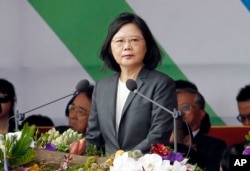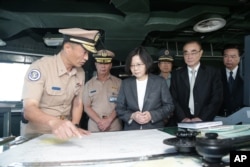Taiwan’s president is emphasizing the need for the island to beef up its defense industry in the face of threats from mainland China.
President Tsai Ing-wen, who took office in May 2016, has accelerated that development largely in aerospace, submarines and cyber security. In June, her government set up a special command to work on cyber security, including research on electromagnetic technology, such as the signals that make internet technology devices run.
Tsai emphasized indigenous defense in a National Day address Tuesday, saying, “We will continue proactively to build up our indigenous defense industry through technical exchanges.”
“In the current phase, we are committed to building our own military jets and submarines, which, particularly for young engineers and researchers, will create many new job opportunities,” she said. “I trust that a more robust defense industry will not only strengthen our military capabilities, but prove beneficial to our overall industrial development as well.”
Tsai also called cyber warfare a “growing threat” and said Taiwan “must be more prepared” for it.
Trainer jets and subs
Taiwan is building a trainer jet and developing a submarine to help fulfill President Tsai's goal of a more self-sustaining military as foreign countries hesitate to sell it arms over fears of upsetting its chief rival China.
The island, located 160 kilometers from mainland China, is preparing to fly a second generation advanced trainer jet to improve pilot skills, according to Ministry of National Defense spokesman Chen Chung-chi. The island government also hopes to replace two submarines bought from the Netherlands in the 1980s due to their age and number of years in service, he said.
In February, the ministry commissioned the Taiwan-based Chung-Shan Institute of Science and Technology to work on the 66 XT-5 Blue Magpie trainer jets, and the institute in turn picked a builder. It is scheduled to fly by 2020, replacing an aging fleet. In January and April, the ministry signed contracts with manufacturers including shipbuilder CSBC Corp. to develop a $3.3 billion submarine within eight years.
“Our two items, the domestically made aircraft and domestically built submarines, are very important indicators,” Chen said. “But these are both aimed primarily at satisfying our own internal needs.”
Indigenous defense plans intensify
The developments are the latest in Taipei’s effort to foster an indigenous defense industry as a way of protecting itself from China.
China sees self-ruled Taiwan as part of its territory. Backed by the world’s third strongest military, it has threatened to take the island by force if needed. China’s diplomatic pressure around the world deters most governments from selling arms to Taiwan, although the United States periodically approves deals.
Weapons production comes naturally for the island, with a half-century record of developing technology such as machine tools and semiconductors.
Over the past 35 years, researchers have developed anti-ship, surface-to-air and air-to-air missiles as well as an indigenous defense fighter and more commonplace sea mines and torpedoes.
In 2015, the now-ruling Democratic Progressive Party said defense policies, including more homemade weaponry, would generate revenues of up to $13.2 billion and create 8,000 jobs.
Lower priority
Taiwan ex-President Ma Ying-jeou did not make indigenous defense a priority during his 2008-2016 term, said Alexander Huang, strategic studies professor at Tamkang University in Taiwan.
His government negotiated briskly with China, reducing the risk of conflict. President Tsai rejects Beijing’s dialogue precondition that Taiwan see itself as part of China, effectively freezing talks and reducing mutual trust. Ma accepted that condition for dialogue.
“In the Ma Ying-jeou administration, that was not a high priority focus, I would say, but now I think the Democratic Progressive Party administration will commit more resources in that area,” Huang said.
Better care for the troops
In another effort to better the military, now ranked the world’s 18th strongest, Taiwan plans to improve recruitment of troops over the coming year by building more “comfortable” housing and offering retirement plans in line with other countries, Chen said.
“Faced with the growing demands of modern warfare, we must ensure that our new generation military focuses not on quantity, but quality,” Tsai said Tuesday.
Taiwan’s military is unlikely, however, to rely fully on its own means, said Huang. Much of its frontline weaponry, such as F-16 fighter jets, still comes from the U.S. Despite a rebuke from Beijing, Washington agreed in June to sell Taiwan $1.4 billion in arms, including torpedoes and high speed anti-radiation missiles.











